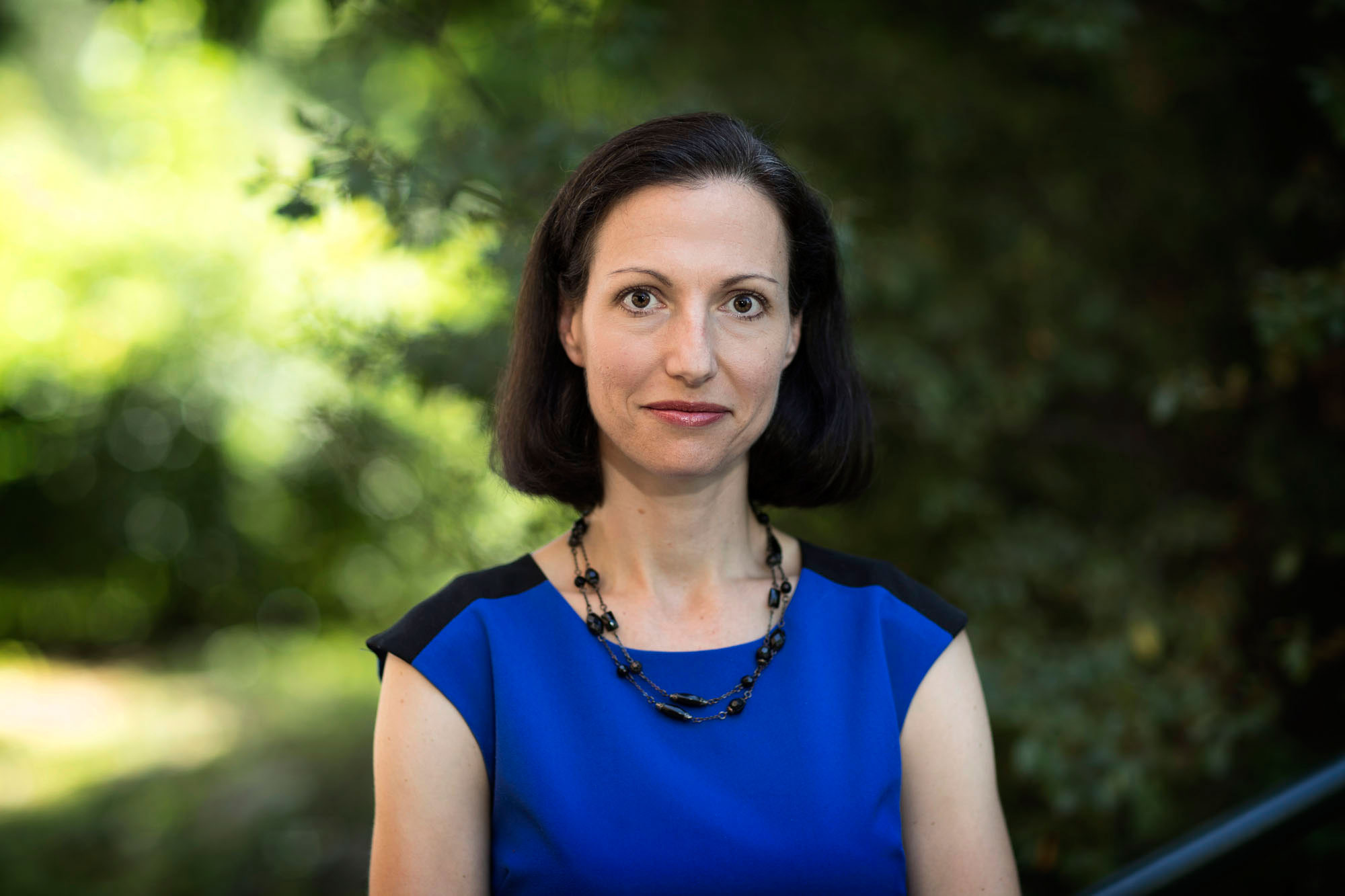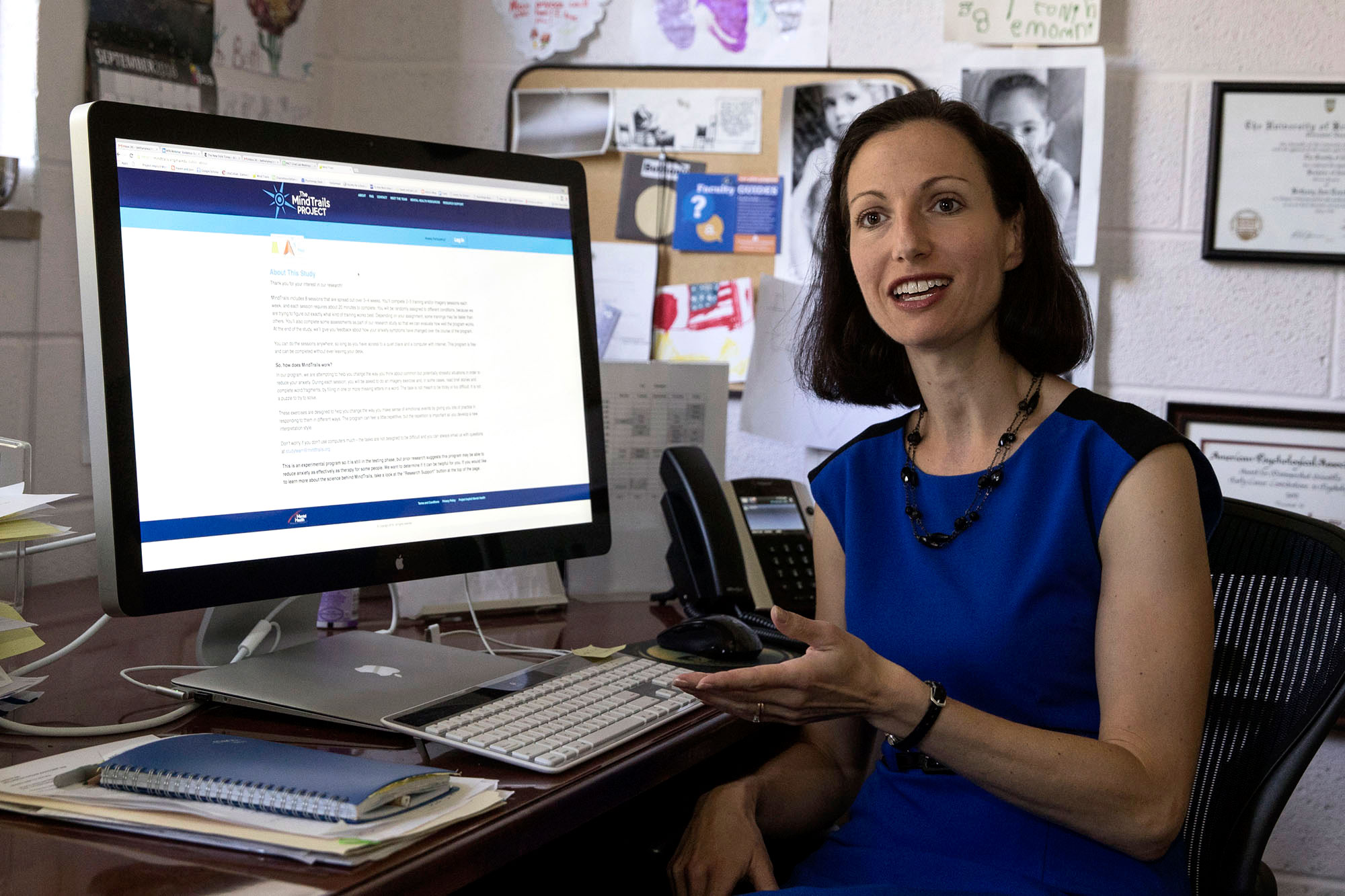The University of Virginia is offering a new, free online tool to help people ease their anxiety from the comfort of their own homes, while at the same time helping researchers continue to refine the program for optimal results.
“MindTrails” offers eight, approximately 20-minute sessions designed to help users modify cognitive biases that could, for example, cause them to feel that they are being harshly judged by others when, in fact, they are not. Users must qualify to participate in the trial.
Bethany Teachman is a licensed clinical psychologist and a professor of psychology at UVA, as well as the director of MindTrails. “The program is based on basic learning principles that give people repeated practice in processing information in new ways to help them interpret their environment in non-threating ways,” she said. “We know that when people are anxious they have a tendency to assume the worst and think that things are going to turn out really badly and that they won’t be able to cope with the situation.”

Bethany Teachman, a professor of psychology at UVA, is the director of MindTrails. (Photos by Dan Addison, University Communications)
MindTrails, she said, is designed to break that mental loop and help people see things in a more objective and flexible way.
At the other end, the program is designed to help its designers refine the online interventions to make them more effective, Teachman said.
Users aged 18 and older are welcome to participate, either in conjunction with other treatment or as a stand-alone intervention. “The goal is to increase flexibility in thinking,” Teachman said.
MindTrails currently has about 200 users and Teachman’s group is inviting others to sign on and start feeling better. A hallmark of anxiety is avoidance of situations, so Teachman is hoping the online aspect will be especially appealing to people who avoid lots of interaction.
She talked with UVA Today about how MindTrails works for both users and researchers alike.
Q. Who designed the program and why?
A. Cognitive bias modification has been around for about 15 years. We are using a modification of these programs that we developed here at UVA. The original developer of cognitive bias modification was psychologist Andrew Mathews. These interventions have shown really nice evidence in the laboratory of being helpful to individuals who are anxious. We want to share these materials more widely with the general public.
Q. What do users encounter when they log in? What does a session look like?
A. It’s very simple. What people do is read a series of very brief stories, and the stories are ambiguous in some way until the very end of the story. Users are prompted to fill in word fragments to complete the stories and that will assign different meanings, depending on what version of the program they are trying. They will resolve the emotional ambiguity in the story by completing the word fragments. So the approach is designed to be non-stigmatizing and doesn’t require a lot of personal disclosure for people who may be less comfortable with that.
People get a lot of practice in thinking about situations that are potentially emotionally relevant and learn how to think about those situations in new ways.
Q. What is your target audience? Is there an age range?
A. We ask that it be adults 18 years of age or older. We are keeping it really open because our goal is to make it as accessible as possible.
By recruiting large numbers of people to participate in our study, it puts us in a good position to evaluate which interventions are more effective for different groups – for example, if you are an older person or a younger person.
We want to make it widely accessible because enormous numbers of people are suffering from anxiety problems, but only a small portion of those folks are getting treatment. For example, only half of those with social anxiety disorder will ever seek treatment, and that is typically after 15 to 20 years of suffering from symptoms. That’s a really depressing statistic that we want to change.
Q. Is there a limit to how many people can participate?
A. No, there is no limit. That is why we are offering it online. It is something that is highly scalable.
Q. Is there a cost or a stipend for participants?
A. Neither. Our goal is to make this a Web-based infrastructure where we are constantly testing new iterations of the program so we can make them better and better.
Q. What kind of feedback do users get?
A. We have users do assessments at various points throughout, and at the very end of the follow-up period we provide them with a graph that shows changes in their anxiety symptoms over the course of the intervention. If users want additional interventions, we also provide links on our site to other mental health resources. On that list, we include not only ways to get face-to-face therapy, but also links to other online programs, mobile apps and self-help books.
Q. Will all of the users be assigned the same assessment material?
A. No. There are different variations of the program which will be randomly assigned to users. We think some will be more helpful than others at shifting different thought patterns, but we need to be able to test them to find out. For anyone who is assigned to a test version that we think may not be the most effective based on our knowledge right now, we then offer them another iteration, so that everyone in the study will ultimately be offered the intervention we think will be most effective. We have a hypothesis about which iterations will be most helpful, but we have to test for that.
Q. What is the benefit to the user and to the research team?
A. In terms of the benefit to the user, we like to be upfront that we are testing new interventions, so we can’t give guarantees, but these programs have often shown good evidence in the lab and the clinic as being helpful to people. We are hopeful that these benefits will happen for participants who are trying these studies online, but some prior results have been mixed, so we are testing new versions of the program that we hope will be especially helpful to people doing the program online.
For the research, by participating in the study, not only do we hope individuals will benefit now, but we also believe they are helping the next generation of individuals who are struggling with anxiety. The goal of this website is to make these interventions better and better and more readily scalable to be disseminated to wide groups of people who are struggling with anxiety. Because we are trying out different variations of the intervention, we can figure out which is going to be strongest for which group. For example, we could find out that people with a particular symptom profile, or a particular age group, benefit more from one intervention versus another intervention and then we can learn how to tailor these interventions. We need large groups of people to try out different versions of the interventions to figure that out.
Q. Does this project have an end date?
A. We don’t have a specific end date in mind. What we want to do is have this be an ongoing research site where we are simultaneously offering the current best version of the program to people for free while, at the same time, testing new versions to make it even stronger.
The wonderful thing about research is that it’s never done. We don’t want to be satisfied with showing that this just works on average for most people. What we want to do is keep doing iterative testing to make it better and better so it can reach more people and personalize it to match the needs of a given individual.
Media Contact
Article Information
September 15, 2016
/content/doctor-online-anxiety-therapy-helps-patients-and-researchers

